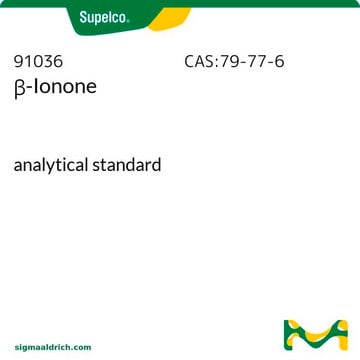58180
β-Ionone
purum, ≥95.0% (GC)
Synonym(s):
4-(2,6,6-Trimethyl-1-cyclohexenyl)-3-buten-2-one
About This Item
Recommended Products
grade
purum
assay
≥95.0% (GC)
refractive index
n20/D 1.52 (lit.)
n20/D 1.521
bp
126-128 °C/12 mmHg (lit.)
density
0.945 g/mL at 25 °C (lit.)
SMILES string
CC(=O)\C=C\C1=C(C)CCCC1(C)C
InChI
1S/C13H20O/c1-10-6-5-9-13(3,4)12(10)8-7-11(2)14/h7-8H,5-6,9H2,1-4H3/b8-7+
InChI key
PSQYTAPXSHCGMF-BQYQJAHWSA-N
Looking for similar products? Visit Product Comparison Guide
replaced by
hcodes
pcodes
Hazard Classifications
Aquatic Chronic 2
Storage Class
10 - Combustible liquids
wgk_germany
WGK 2
flash_point_f
258.8 °F - closed cup
flash_point_c
126 °C - closed cup
ppe
Eyeshields, Gloves, type ABEK (EN14387) respirator filter
Choose from one of the most recent versions:
Certificates of Analysis (COA)
It looks like we've run into a problem, but you can still download Certificates of Analysis from our Documents section.
If you need assistance, please contact Customer Support.
Already Own This Product?
Find documentation for the products that you have recently purchased in the Document Library.
Our team of scientists has experience in all areas of research including Life Science, Material Science, Chemical Synthesis, Chromatography, Analytical and many others.
Contact Technical Service







